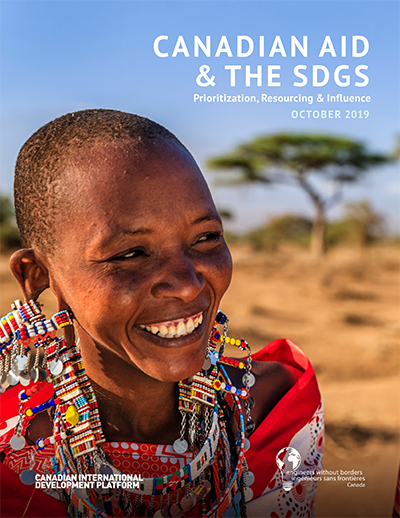Canadian Aid and the SDGs
A Data-Driven Analysis of Prioritization, Resourcing, and Influence
The Canadian International Development Platform (CIDP) proudly presents our joint report with Engineers Without Borders (EWB), Canadian Aid and the SDGs: Prioritization, Resourcing, and Influence, an assessment of how Canada has positioned its international assistance with respect to the Sustainable Development Goals.
The assessment uses three criteria: prioritization, or how well has Canada prioritized areas of focus within the SDGs; resourcing, or how well has Canada resourced priority areas; and influence, or has Canada leveraged its non-financial influence effectively?
Key Messages
1. Prioritization: How well has Canada prioritized areas of focus within the SDGs?
Since the adoption of the Feminist International Assistance Plan (FIAP), Canada has effectively prioritized spending across the SDGs. The authors demonstrate that the focus is SDG5 (Gender Equality). The FIAP’s key performance indicators link most frequently and closely with SDG5.
Canada’s aid is much more concentrated (top five SDGs make up 92% of its ODA spending) which reflects prioritization driven by SDG5, especially when compared to the Organisation for Economic Co-operation and Development’s (OECD) average (76%). Compared to similar-sized donors, Canada’s level of concentration is among the highest. Gender and health are clear Canadian development priorities. Canada’s share of DAC gender-related health ODA is 2.7 times its share of DAC ODA.
However, not all priority areas feature this prominently. Specifically, Canada’s share of climate ODA is lower than its share of total DAC ODA and despite an increase in focus on this area in the lead up to and since COP21, Canada’s investments have not kept pace with leading climate-related ODA providers.
2. Resourcing: How well has Canada resourced priority areas?
Although, at the absolute level, Canada’s international assistance spending has increased ($3.6 billion), in relative terms (using the ODA/GNI aid generosity ratio), Canada’s ODA is near an all-time historic low (0.28% GNI). Moreover, while Canada ranks in the bottom half of the OECD-DAC on the ODA/GNI ratio, it ranks among the leading donors in its priority areas (health, humanitarian assistance and gender-related aid spending). On resourcing at the overall envelope level, the timing of the roll out of increases (announced only in Budget 2018 and 2019) is a key issue. It is estimated that the International Assistance Envelope (IAE) has been growing at between 3% and 4% since the start of its term, and that it will grow at approximately 3 to 3.5% out to 2023-24. The analysis suggests that the IAE will be at approximately $6.1 billion by 2023-24. While recent increases may stabilize a declining envelope, they are unlikely to be enough to increase Canada’s ODA/GNI ratio meaningfully.
Moreover, Canada’s spending on climate action in developing countries is almost exclusively multilateral. This implies opportunities to work with and through bilateral channels (such as with Canadian NGOs, climate research institutions and the private sector) are not being seized. As a result, despite increases, Canada does not rank among the major climate-related ODA providers.
3. Influence: Has Canada leveraged its non-financial influence effectively?
Canada has used global forums to highlight its priorities and leverage its influence beyond purely monetary terms in several key areas. Key examples of this include:
- Canada’s G7 Presidency in 2018, which helped galvanize significant investment towards quality education for women and girls in fragile and conflict-affected states.
- The creation of the Gender Equality Advisory Council, which helped elevate women’s economic empowerment as a priority area.
- Another area of influence is the Group of Friends of SDG Financing initiative, led by the Permanent Representative of Canada to the UN. The initiative aims to provide a platform to leverage private capital (such as from institutional investors and pension funds) towards the SDGs.
- Canada’s newly formed DFI (FinDev Canada) helped galvanize other G7 DFIs to commit to the ‘2X Challenge’ which aims to mobilize $3 billion towards women’s economic empowerment in developing countries.
- Canada has also helped increase the profile of the Women, Peace and Security agenda and UN resolution 1325. In 2019, Canada appointed a new Ambassador for Women, Peace and Security.
- Hosting the world’s largest conference on gender equality, Women Deliver 2019. Canada announced a commitment to spend $1.4 billion annually on women and girls’ health (starting in 2023) at the conference.



Recent Comments